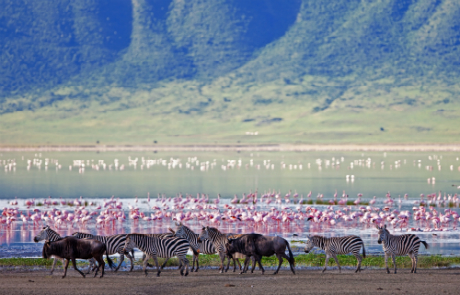Ngorongoro Crater
In 1951, the enormous Serengeti National Park was declared, encompassing the present Serengeti, plus the Ngorongoro area and surrounding Crater Highlands. Today, this is split into the present-day Serengeti National Park, and the current Ngorongoro Conservation Area. The conservation area now encompasses a large area of the short-grass plains on the southern side of the Serengeti Plain and also the Ngorongoro Highlands, a range of largely extinct ancient volcanoes on the west side of the Great Rift Valley.
Ngorongoro Crater Safari
The showpiece of the conservation area is undoubtedly the Ngorongoro Crater which was created when a large volcano exploded and collapsed on itself two to three million years ago. It was declared a UNESCO World Heritage Site in 1978 and is the largest intact volcanic caldera in the world.
It measures about 16-19km in diameter, with walls of 400-610m in height. However you measure it, the Crater is a strong candidate for any list of the world’s greatest natural wonders. It is renowned both for its geological splendour, and for being a natural reserve which is home to some of the densest large mammal populations found anywhere in Africa.
Ngorongoro wildlife Safari
Due to the enclosed nature of the Crater it has virtually formed its own ecosystem. Besides the stunning scenery, one of the main attractions of this area is the variety of flora and fauna found in a remarkably compact area all year round. In the South west corner there is the Lerai Forest, which is mainly comprised of yellow fever trees (a member of the acacia family). To the north of the forest is a shallow soda lake called Lake Magadi and to the east you will find Gorigor Swamp and the Ngoitokitok Springs where pods of hippo are to be found. The north of the Crater is consists of the open grasslands which characterises the Crater floor; this is where the majority of the resident game resides.
You are guaranteed to see large concentrations of game on any Ngorongoro safari. The mineral-rich floor of this spectacular bowl is largely flat, open and covered in nutritious grasses – much to the liking of large herds of zebra and wildebeest, which graze here. These extensive open plains are also home to herds of buffalo, Thomson’s gazelle, Grant’s gazelle and tsessebe (often called topi). You’ll also find East Africa’s best population of black rhino here, which are often seen in open grasslands. Breeding herds of elephant pass through the Ngorongoro Crater itself only rarely, but you will see a scattering of old bulls, including some of the biggest tuskers left alive in Africa today. The only surprising absentees from the Crater are Impala and Giraffe; it is thought that this is perhaps because of the lack of open woodlands and browsing species of trees which these two tend to thrive on.
The high numbers of herbivores supports the densest populations of predators found anywhere in Africa. The reliable presence of these predators has helped to make Ngorongoro safari so popular. The Crater’s lion population varies significantly over time, the one constant being their complete disregard of vehicles; they will hunt within yards of a vehicle, and when exhausted even seek shade beside them. Spotted hyenas are even more common here, often competing with the lion, and there’s are a small but growing number of cheetah. Leopards are around, especially in the vicinity of the Lerai Forest. Side-striped and the lovely golden jackal are often seen skulking around, whilst bat-eared foxes are a rarer sight.
Access to Ngorongoro Safari
The Ngorongoro crater and wider conservation area is easily accessible. There is a daily light aircraft flight to Arusha from Dar (other airstrips in Tanzania also fly to Arusha) where you would then be met by a safari guide in a close-sided pop-top 4 x 4 safari vehicle. Your guide will stay with you for your time down in the Crater (maximum 6 hours for the crater tour always). The drive from Arusha is around 4 hours to begin an Ngorongoro Crater safari.
Another alternative is to fly to Manyara airstrip, which is about an hour from the Crater. Depending on where you’re staying – you may be met by the lodge, or picked up by a private driver guide.
There are further constraints on the timing of visits, with guests restricted to a maximum of 6 hours between 0700 and 1800.
Where to stay
There is no accommodation within the Ngorongoro Crater and so generally speaking there are two different options; either staying on the Crater rim or on the Rift Valley Escarpment. There is a collection of lodges perched on the Crater rim overlooking the floor. These lodges tend to have incredible views and easy access to the crater, however the prices reflect this. The Ngorongoro Crater Lodge is the most luxurious option but it is also the most expensive. The other Lodges that have views of the Crater floor are the: Ngorongoro Serena Safari Lodge; Ngorongoro Wildlife Lodge; and the Ngorongoro Sopa Lodge. These lodges are much larger and also benefit from an exceptional view.There are a handful of other lodges and camps in the hills of the Crater, which do not have the views but are still extremely convenient and are also more affordable, an example of this is the Rhino Lodge.
Alternatively you could choose to stay on the nearby Rift Valley Escarpment in an area often referred to as Karatu. The lodges and camps here are all less than about 20km from the Crater and have a lot more character than the aforementioned lodges. Gibb’s Farm, Plantation Lodge and the Ngorongoro Farmhouse Lodge are all true of this.
Other attractions of the Ngorongoro Conservation Area
Empakaai Crater
Only 90 minutes’ drive from the Ngorongoro Crater, Empakaai Crater is much smaller, yet endearing in its own way. A deep soda lake covers about half of the 6km wide caldera. You’ll often find thousands of flamingos in the shallows of the emerald lake – giving it a spectacular pink tinge. You can drive up to the outer rims of the crater, before taking the 45-minute walk down the path through the forested slopes to the crater floor. The views from the rim over the crater to Ol Doinyo Lengai are thought to be some of the most spectacular in Africa – on very clear days you can even see Kilimanjaro and Lake Natron. Empakaai Crater is a great day trip to consider for those spending more than two nights in the Ngorongoro area.
Olduvai Gorge
The Ngorongoro Conservation Area does not only generate interest purely based on wildlife, the area has also got arguably the most extensive history of any place on earth. It has been proved that various Hominid species have lived there for millions of years. This has been discovered because of fossils preserved in volcanic rock, which date back to 3.6 million years ago. The 30 mile long Olduvai Gorge is a steep-sided ravine in the Great Rift Valley. This is one of the most important prehistoric sites in the world and has been instrumental in understanding human evolution. This is well documented in the museum, which has replicas of some of the hominid fossils unearthed at the site, as well as the Laetoli footprints (the most ancient footprints ever found). It also has genuine fossils of some of the extinct animals that used to live in the area. We can arrange day trips to the Gorge and the museum, which is an interesting addition to an Ngorongoro safari.

